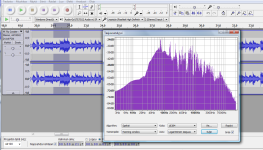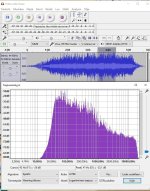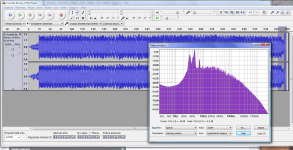FSAF is a measure of Total Distortion, including harmonic & intermodulation + NoiseATM, I don't think your FSAF THD measurements have any relationship to Distortion measured by Angelo or Stepped Sine
The FSAF Distortion residual can be saved as a .WAV file, that you can hear…
It remains to be seen how well FSAF correlates with existing measurement process eg. Exponential sine sweep aka chirp (since 2000) or Maximum Length Sequence (C20, DOS 386 era)
The criticism levelled at the my, or sm52’s testing on the REW thread should understood as user error/ Garbage In Garbage Out, or as working through the kinks of a beta release.
And not conflated with the mathematics of FSAF. I know you understand this, but I wanted to state it for bystanders in case they feel like we are going around in circles. You may argue with the math, but unless I’ve done my own coding for MLS, ESS and/FSAF, I won’t. And it’s not clear if I can fathom the pros and cons of each (yet).
The FSAF measurement is the only one where I can listen to the Distortion residual.
Fun/novel or useless?
The truth is perhaps something in between, but we will see.
Last edited:
@kgrlee: I am no DSP guru. I am just an audio enthusiast trying to have fun building speakers (and learning more about the technical side of it a little bit more every day) as far as this forum is concerned. I do understand little bit of DSP though.
As far as my regular day job is concerned, I have a PhD in wireless communication system design (applied DSP) and a combined 10 years of such system design experience.
About FSAF, I have started reading through part-1. Been through about 20 pages only. I will take time to read and understand it during my leisure time since my day job takes 12+ hours of my time everyday. And when (if) I understand it. I will try to explain/summarize/discuss the concepts involved to the best of my understanding here.
But the papers/articles that have been cited in Michael's work are solid foundational references in the area. And from the "vibes" that I get so far reading his article, I feel his work is the work of a genius.
@tktran303/ Thanh
You are right. Many geniuses dont tolerate much BS. I am no genius but I have been fortunate enough to have been around a few. Many of them may be short tempered, may not be able to dumb down concepts beyond a certain level and may have emotional rollercoaster rides occasionally. Many of them value their time/efforts greatly but problems get intolerable for them when others around them don't.
I am sad that Michael left this forum. It may have been due to frustration from some of the circular arguments/time wasting convincing arguments etc going on in his other thread and some other threads that he has been participating in. Or maybe he has left for some other reason.. Anyway, I wish him the best and hope that he comes back at whatever time he chooses to.
As far as my regular day job is concerned, I have a PhD in wireless communication system design (applied DSP) and a combined 10 years of such system design experience.
About FSAF, I have started reading through part-1. Been through about 20 pages only. I will take time to read and understand it during my leisure time since my day job takes 12+ hours of my time everyday. And when (if) I understand it. I will try to explain/summarize/discuss the concepts involved to the best of my understanding here.
But the papers/articles that have been cited in Michael's work are solid foundational references in the area. And from the "vibes" that I get so far reading his article, I feel his work is the work of a genius.
@tktran303/ Thanh
You are right. Many geniuses dont tolerate much BS. I am no genius but I have been fortunate enough to have been around a few. Many of them may be short tempered, may not be able to dumb down concepts beyond a certain level and may have emotional rollercoaster rides occasionally. Many of them value their time/efforts greatly but problems get intolerable for them when others around them don't.
I am sad that Michael left this forum. It may have been due to frustration from some of the circular arguments/time wasting convincing arguments etc going on in his other thread and some other threads that he has been participating in. Or maybe he has left for some other reason.. Anyway, I wish him the best and hope that he comes back at whatever time he chooses to.
Member
Joined 2003
Here you go, normalized the audio level to make it easy to hear. This was a sine sweep, to match the stimulus of the HD measurement it was being compared to. Funny, it sounds just like you'd expect it to - transformer hum.View attachment 1370373
Can I have a listen to this?
Attachments
Perhaps this thought is too simplistic, but if FSAF is used with an exponential sine sweep, the same signal as REW, this should enable a fair comparison of distortion+noise between the two algorithms... ?
Never really aspired to listen to sine sweeps, music is far more interesting. I don't hear any noise and distortion, should I worry that my ears are letting me down or is it just that my equipment is better than I need.
great lateral thinking of @DcibeL to use a .WAV file of REW actual Measurement sweep (using REW's Generator function), as the stimulus, so he could peek at how the FSAF graph appears, when compare the equivalent ESS as measured by REW.
The value of FSAF, in my view, is in its ability to use real music as a stimulus. Crank up your favourite wave editor, clip out a minute of your favourite song, and send it through FSAF.
The more people publish the true measurement results on real music...
The value of FSAF, in my view, is in its ability to use real music as a stimulus. Crank up your favourite wave editor, clip out a minute of your favourite song, and send it through FSAF.
The more people publish the true measurement results on real music...
Facinating! I don't have REV, would not really know what I would need it for. May I retain the status of a hi-fi enthusiast? I know I cannot be an audiophile, but that is okay.
Member
Joined 2003
Post 57 uses same sine sweep signal, so stimulus is the same as HD measurement. For this simply loopback however, pink noise provides nearly equal result despite the change in crest factor.And @decibel, what stimuli in posts #57 and #58? This is from now on a parameter that one have tollways state if using FSAF ;-)
//
Post 58 is not strictly apples to apples. HD is a sine sweep, FSAF is using pink noise. Same RMS level.l, but here the pink noise provides higher crest factor, perhaps some contribution to the different result on a real speaker.
I think Mikets would think we are being very silly to try to make comparison to HD sweep and using sine stimulus for FSAF.
Finding the link to downloading the beta is the hardest part...
https://www.avnirvana.com/threads/rew-api-beta-releases.12981/
I wonder if it was done that way to avoid FAQ #546... where the answer is RTFM...
It is eazypeazy. Just ignore yours truly who had screwy ASIO drivers to fight with, by Focusrite. Or was that Windoze? Anyway I digress. Just download and play with it, we'll walk you through it.
https://www.avnirvana.com/threads/rew-api-beta-releases.12981/
I wonder if it was done that way to avoid FAQ #546... where the answer is RTFM...
It is eazypeazy. Just ignore yours truly who had screwy ASIO drivers to fight with, by Focusrite. Or was that Windoze? Anyway I digress. Just download and play with it, we'll walk you through it.
Last edited:
Member
Joined 2003
Fwiw there's a beta button on the REW main page, so it shouldn't be too hard to find.
The measurement process is indeed Easy peasy, but requires some competent measurement equipment. No USB mics allowed 😉. I use Motu M4 and Line Audio Omni1 mic. I haven't read anythin at Audionirvana to know what struggles others are having.
Start by RTFM.
https://www.roomeqwizard.com/betahelp/help_en-GB/html/fsafmeasurement.html
The measurement process is indeed Easy peasy, but requires some competent measurement equipment. No USB mics allowed 😉. I use Motu M4 and Line Audio Omni1 mic. I haven't read anythin at Audionirvana to know what struggles others are having.
Start by RTFM.
https://www.roomeqwizard.com/betahelp/help_en-GB/html/fsafmeasurement.html
Is a software sine-wave as pure as an analogue generated sine wave? Visibly it is quite a bit different some steps are clearly visible thus containing a lot of artifacts not necessarily related to the fundamental.
I'll be surprised if the ability to use real music ends up being a major value creator.The value of FSAF, in my view, is in its ability to use real music as a stimulus. Crank up your favourite wave editor, clip out a minute of your favourite song, and send it through FSAF.
Meyer Sound introduced its dual channel FFT SIM System (Source Independent Measurement) in the early to mid '80s, and had a commercial SIM2 analyzer out in the early nineties.
Smaart, from its starting days mid-90's when owned by JBL professional, through today now owned by Rational Acoustics, has had source independent capability.
Source independent has let music, speech, noise, sequences, whatever, ....recorded or live, be used as the reference signal.
I've been using Smaart since around 2000, and quicky found that using music as a stimulus is cool and greatly appreciated when measurements need to be done without annoying people.
The music has to be spectrally dense though. (Or like I mentioned earlier, have inaudible full-spectrum pink noise mixed into the track.)
I also think that M-Noise has probably taken away most of an advantage music might have in offering a more real-world crest factor.
Supposedly a great deal of various types of music's' crest factors were analyzed to come up with a surrogate noise with a frequency-dependent crest factor.
Anyway, point of the above is to say that ime, good ole sweeps or noise are the way to go...particularly for measurements of the low end of the spectrum.
I don't really see that music adds anything.. (other than reducing annoyance)
This is what I see as truly unique, and has my keen interest.The FSAF measurement is the only one where I can listen to the Distortion residual.
Fun/novel or useless?
The truth is perhaps something in between, but we will see.
I might be prematurely pessimistic though, because I suspect the residual is going to be buried low enough in the SNR scheme of things,
to end up being more of a curiosity than a speaker building/tuning help. HOPE I'M VERY WRONG 🙂
I agree with mark100!
I don't have a 2-ch measurement system, so FSAF is not possible. Still I think that it is a too complicated way to measure THD+N. Music signal spl spectrum/amplitude as such doesn't stress speakers as sine sweep or white noise, so it has a benefit of weighting the most annoying low-midband distortion. But being able to listen to D+N alone adds no value to me.



ps. sine sweep is good for measuring signal chain, but still I don't put much value for classD kind of elevated distortion above 10kHz.
I don't have a 2-ch measurement system, so FSAF is not possible. Still I think that it is a too complicated way to measure THD+N. Music signal spl spectrum/amplitude as such doesn't stress speakers as sine sweep or white noise, so it has a benefit of weighting the most annoying low-midband distortion. But being able to listen to D+N alone adds no value to me.



ps. sine sweep is good for measuring signal chain, but still I don't put much value for classD kind of elevated distortion above 10kHz.
Last edited:
Regarding measuring signals. If the speaker really did behave differently whether it received a full range noise/random signal or a standard sweep. Wouldn't it then show different results from either a MLS vs sweep?
When I get this working I will test with different kind of music material to see if there are any differences...
//
//
But using REW's FSAF measurement you only need one for instance UMIK-2?I agree with mark100!
I don't have a 2-ch measurement system, so FSAF is not possible. Still I think that it is a too complicated way to measure THD+N. Music signal spl spectrum/amplitude as such doesn't stress speakers as sine sweep or white noise, so it has a benefit of weighting the most annoying low-midband distortion. But being able to listen to D+N alone adds no value to me.
View attachment 1370607View attachment 1370608View attachment 1370609
ps. sine sweep is good for measuring signal chain, but still I don't put much value for classD kind of elevated distortion above 10kHz.
But this was possible as far back as 20 years ago, see my old "Distortion Isolation" article at https://www.libinst.com/distortion_isolation_in_the_time.htm .The FSAF measurement is the only one where I can listen to the Distortion residuaL
There are even downloadable sample files of isolated distortion+noise there.
I never found a lot to hear with electronics only signals (which situation inspired the later Audio DiffMaker program). With loudspeaker+microphone signals a limitation was getting a quiet enough environment so that noise doesn't dominate everything. I think isolating the distortion in the loudspeaker (voice coil) impedance rather than in a sound field would get around most of that.
This is what I see as truly unique, and has my keen interest.
I might be prematurely pessimistic though, because I suspect the residual is going to be buried low enough in the SNR scheme of things,
to end up being more of a curiosity than a speaker building/tuning help. HOPE I'M VERY WRONG 🙂
Approaching things with skepticism is healthy approach.
@bwaslo Was this incorporated into a release of Praxis or some other?
I'd like to test ESS, FSAF and your implementation empirically, and compare and contrast.
With loudspeaker+microphone signals a limitation was getting a quiet enough environment so that noise doesn't dominate everything. I think isolating the distortion in the loudspeaker (voice coil) impedance rather than in a sound field would get around most of that.
For sure the environment noise floor and microphone dynamic range is a major limitation. This caveat is also explained in the REW manual.
But this is NO different from every other "distortion" testing of the last decade using Farina ESS. If my measurement instrument (DAC/ADC/amplifier/mic pre amp/microphone has as higher or higher distortion than the DUT, then this is a problem that first needs solving.
PS.
I'm not going to test MLS. I'll leave that to users who are using software packages like MLSSA, WinMLS(Pro). I'm not interested in finding an old 486/DOS/WindowsXP system to relive the glorious (painful) days.
Last edited:
- Home
- Loudspeakers
- Multi-Way
- Measuring speakers using music (Michael Tsiroulnikov's FSAF)